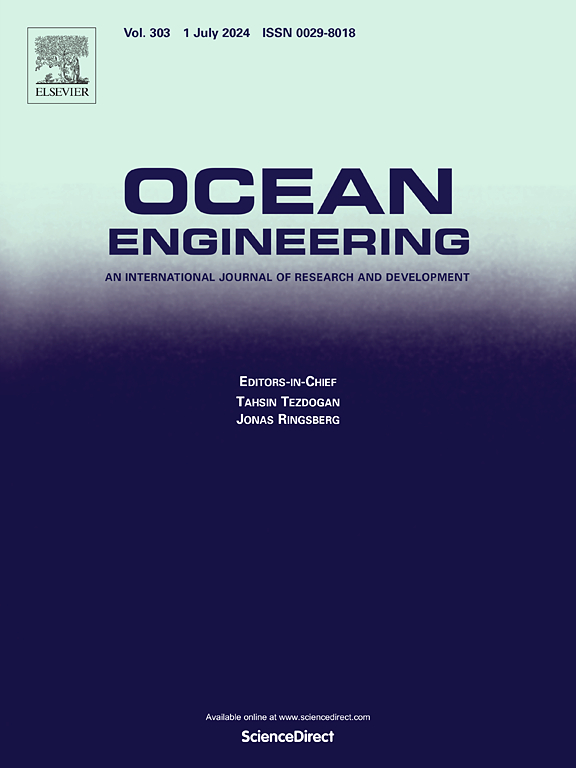Hydrodynamic performance and energy efficiency of an undulating fin based on the composite motion of oscillation and pitch
IF 4.6
2区 工程技术
Q1 ENGINEERING, CIVIL
引用次数: 0
Abstract
Fish-like robots have become underwater vehicles with broad application prospects, owing to their flexibility and adaptability. Inspired by the swimming motion of fish, an undulating fin with composite motion is proposed in this study. The composite motion is a combination of oscillation and pitch perpendicular to and parallel to the horizontal direction, respectively. First, the kinematic and dynamic modes of the motion mechanism in the free propulsive mode are established with variable locomotive parameters, such as the oscillating frequency and deflection angle. The hydrodynamic performance of the undulating fin is then investigated through analyses of the force mechanism, propulsive velocity, non-dimensional number, and vortex flow using the dynamic mesh method. The energy efficiency of the composite motion of undulating fin is compared with that of a simple oscillating motion. Finally, experimental measurements of an undulating-fin robot prototype are conducted. The results show that the underwater robot accelerates to a maximum velocity of 0.54 m/s with a frequency of 2.5 Hz. Owing to the composite motion, alternating high and low-velocity regions occur in the surrounding fluid of the undulating fin. The highest energy efficiency is 0.88 with a frequency of 2.0 Hz, and the maximum improvement is 10.1% compared with the simple oscillating motion. A streamwise central jet is formed with vortices shedding into the wake flow, which generates a thrust force with two peaks and troughs in one cycle. The negative and positive vorticities correspond to the alternation of the pressure distribution. The experimental measurements demonstrate the propulsive velocity and force are consistent with the numerical simulation. The composite motion with a higher Strouhal number reflects the considerable instability of the flow.
基于摆动和俯仰复合运动的起伏鳍的水动力性能和能效
鱼类机器人因其灵活性和适应性,已成为具有广阔应用前景的水下运载工具。受鱼类游泳运动的启发,本研究提出了一种具有复合运动的起伏鳍。复合运动分别是垂直于水平方向的摆动和平行于水平方向的俯仰。首先,在摆动频率和偏转角等运动参数可变的情况下,建立了自由推进模式下运动机构的运动学和动力学模式。然后,利用动态网格法,通过对力机制、推进速度、非维数和涡流的分析,研究了起伏鳍的流体力学性能。起伏鳍复合运动的能量效率与简单摆动运动的能量效率进行了比较。最后,对起伏鳍机器人原型进行了实验测量。结果表明,水下机器人的最大加速度为 0.54 米/秒,频率为 2.5 赫兹。由于是复合运动,起伏鳍周围流体中出现了高速和低速交替区域。与简单的摆动运动相比,频率为 2.0 Hz 时的最高能量效率为 0.88,最大提高幅度为 10.1%。流向中心的射流与尾流中脱落的涡流一起形成了推力,在一个周期内产生了两个波峰和波谷。正负涡流与压力分布的交替相对应。实验测量结果表明,推进速度和推进力与数值模拟结果一致。斯特劳哈尔数越高,复合运动越大,这反映出气流相当不稳定。
本文章由计算机程序翻译,如有差异,请以英文原文为准。
求助全文
约1分钟内获得全文
求助全文
来源期刊

Ocean Engineering
工程技术-工程:大洋
CiteScore
7.30
自引率
34.00%
发文量
2379
审稿时长
8.1 months
期刊介绍:
Ocean Engineering provides a medium for the publication of original research and development work in the field of ocean engineering. Ocean Engineering seeks papers in the following topics.
 求助内容:
求助内容: 应助结果提醒方式:
应助结果提醒方式:


